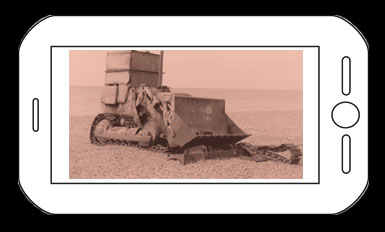Over the course of the next several months, I will be posting a series of reflections on the challenges and opportunities around creating a college-level course on authoring eBooks and mobile apps in the context of the humanities.
“In 2001, I published “Digital Natives, Digital Immigrants,” a two-part article that explained these terms as a way of understanding the deep differences between the young people of today and many of their elders. Although many have found the terms useful, . . . the distinction between digital natives and digital immigrants will become less relevant. . . . Digital wisdom transcends the generational divide defined by the immigrant/native distinction.” – Mark Prensky, “H. Sapiens Digital: From Digital Immigrants and Digital Natives to Digital Wisdom” (Innovate Journal of Online Education 5:3 2009).
“[E]ven if our students are exposed early—and repeatedly—to visual material, be it through video games, television, advertisements, the World Wide Web, or a host of other media, and even if they have access to and skills with visual communication technologies, we cannot assume they are visually literate, as the digital natives argument suggests.” – Eva Brumberger, “Visual Literacy and the Digital Native: An Examination of the Millennial Learner” (Journal of Visual Literacy 30:1 2011).
Some of my fondest childhood memories involve having the opportunity to work on a vehicle with my Dad—burning rusted bolts from a stubborn starter with a oxyacetylene torch, bathing carburetors in sweet-smelling solvents before tearing them apart, or even just using a pneumatic wrench to remove an inner tire from the rear axle of one of his Ford dually pickup trucks. I was never very good—I didn’t work enough on cars and trucks to ever be very proficient at it. Mostly, I treasured the time with my Dad.
But I was a “vehicle native.” I drove anything I could with wheels since I was twelve (farm tractors, rider lawnmowers, mopeds, and various large vehicles around our yard to “get them out of the way”) and, notwithstanding a few fender benders, have been fairly proficient at using them ever since. But as soon as something goes wrong, this “vehicle native” has to take his Prius to the dealer and hope beyond hope that the repairs will run under a thousand dollars. I have no ability to fix anything having to do with my car (much to my father’s chagrin).
Similarly, as Brumberger points out above, our students may have been raised in and around digital technology, but it is my experience that this exposure only makes it harder for them to learn. When something doesn’t work out the way they intend it to, they freeze, or disparage, or even drop the course unless I intervene. The many students in my classrooms over the last 15 years or so expect practical, unproblematic results, and when something goes awry, it’s time to take it to an expert (just as I do with my car).
Therefore, as I imagine a course that asks students to compose for mobile devices, my past experiences in digital technology allows me to assert some general assumptions about what to expect from students on the first day:
- Students, native or not, will not all possess mobile devices of their own; of the ones that do have devices, I can be assured each device will vary in make, model, and whatever customization students choose.
- Students, native or not, will largely consider themselves to be “not very good” with technology, and most will probably carry with them this anxiety throughout the course. Sometimes, I can do little to help them see otherwise (though I have seen some epiphanies in my time).
- The ability to creatively solve problems and deal with the inevitable issues that arise when asking them to author in a digital environment will vary dramatically, and it will vary mostly in proportion to the student’s willingness to persevere.
- Interface issues of design, the rhetoricity of image, and the importance of constructing a user-experience consistent with their persuasive purpose will all be a challenge for all of these students.
- The most successful students in the class will be those who viscerally connect to what they intend to create—my job is in part to create assignments that engage students at this affective level.
Each of these assumptions are challenges I willingly take on every time I teach in the digital classroom. And, more importantly, each of these challenges create teachable moments that address some of the most important outcomes of any course.
The potential, on the contrary, is that these same students, whether they are native or immigrants to technology, see this kind of composing as eminently relevant to their lives. Whatever challenges await (and I would argue that we are all technology émigrés, no matter what our literacy happens to be, because technologies often prove to be more dynamic than our learning cycles), we do want our students to strive to compose rhetorically for their intended audiences, no matter what modes and media are involved. Surely, this goes a long way towards becoming “digitally wise.”
Any view that generalizes a generation as technologically “native” or “immigrant” creates mythologies (and exaggerations, usually) that do not serve our pedagogy, and I think this is what both Prensky and Brumberger are ultimately trying to assert. My own experience in the digital classroom must be at least partially similar to what my Dad must have felt trying to show me how to remove a radiator, find its leak, and patch it: troubleshooting is learning.
So what have you noticed about this millennial generation in the digital classroom? Has your experience been different from this? Is there a tactic or technique you use to address one of the 5 assumptions I make above?
Of course, now I need to think about what I need to learn (and how) in order to teach a course on authoring for mobile devices–the subject of my next post.
